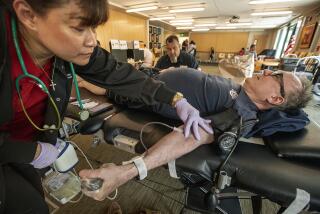Blood Pressure Rises Over Supplies
- Share via
WASHINGTON — Of the 14 million pints of blood donated each year, only 250 come from teenagers at Shawnee Mission North High School in Overland Park, Kan., on the outskirts of Kansas City. But in the intensely competitive business of blood banking, that was plenty to fight over.
Students faced taking sides in a national battle: They could keep giving blood at the local blood bank, which supplies nearby hospitals. Or they could donate to the American Red Cross, which had begun collecting in Kansas City as part of a national effort to increase its share of the blood market.
The Red Cross recruiter trumpeted T-shirts with the school name. The local Community Blood Center warned that the Red Cross would ship blood out of town.
Students chose to stay local. The Red Cross recruiter protested to the principal, a tempest two years ago that annoyed student council advisor Cody Fothergill.
“I love it when high school students do selfless activities, and this was one of them,” Fothergill said. “It did throw us off guard a bit.”
Struggles over blood supply and demand play out across the country. At the center sits an uneasy relationship between the American Red Cross and 75 independent, locally run blood banks. For years, each side has collected about half the nation’s blood supply.
Behind the cookies and juice that are the public face of donation, blood banking is big business. A single pint donated free is divided into multiple products that sell for hundreds of dollars.
The stakes are high. Hospitals cannot function without donors, and experts fear they’ll be turned off by increasingly public friction.
“Everywhere you turn there’s turf wars, there’s price battles, there’s allegations of predatory behavior,” said University of Pennsylvania bioethicist Arthur Caplan, former chairman of the government’s blood oversight committee. “The country is in desperate need of a reassessment of its national blood policy.”
Already, potential donors are confused about when they’re needed. A poll conducted for Associated Press by ICR of Media, Pa., found the main reason people say they’d donate blood is to help after a disaster, even though only blood that has been tested for disease and is on the shelf goes to help disaster victims.
Only 5% of those eligible donate annually. Periodic shortages led 20% of hospitals to postpone elective surgery, an American Hospital Assn. survey found last year.
Tight supply creates tension throughout the system: in the quest for donors, in rising blood prices, in disputes over safety rules. It was on full display after Sept. 11, when the country gave blood in unprecedented force but got conflicting messages about whether donations were needed at once.
And it is transforming the industry. Faced with paying millions more each year, some hospitals have begun forcing competition on their own terms.
Asked about tension in the industry, Red Cross Vice President Trudy Sullivan said blood donations increased last year. Nationwide, donations rose by 7%, a quarter of them in the 10-week aftermath of Sept. 11, the National Blood Data Resource Center said.
Sullivan said the Red Cross is looking at working more closely with competitors: “There’s tremendous potential for all of us in this industry to draw more people in without disruptions between us.”
Blood is donated, but hospitals pay for every drop. Prices vary, in part because it costs more to do business in one city than in another. But the Red Cross generally charges more: about $175 to $200 per bag of red cells, the typical transfusion, the organization said. Independent blood banks report charging an average of $90 to $150.
Some cash-strapped hospitals are responding by forcing new competition. Most striking may be New Hampshire’s Dartmouth-Hitchcock Medical Center, now juggling three suppliers.
After the Red Cross doubled its price last summer to $189 per bag, Dartmouth hired the independent United Blood Services to provide half its supply--at 30% less. Then Dartmouth began recruiting its own donors, collecting 10%; the Red Cross provides the rest.
The tension between the Red Cross and independent suppliers went public after Sept. 11, when half a million people lined up to give blood, even though it turned out little was actually needed.
The Red Cross aggressively encouraged donations, calling it insulting to discourage people who wanted to help. The independents said it was irresponsible to collect blood that would go bad in 42 days and asked people to come back when the supply would need replenishing. At an emergency meeting Sept. 14, federal health officials tried to get both sides to deliver the same message.
Then there are safety disputes. The Red Cross set stricter standards than the government to guard against brain-destroying “mad cow” disease, calling it a “cautious and conservative approach in the face of scientific uncertainty.” Competitors resent any implications that their blood isn’t as good, and the government said the Red Cross couldn’t imply that.
Sometimes, the competition leaves a stalemate. In Charlottesville, Va., hospitals need about 24,000 pints of blood each year, just what residents donate. The Red Cross collects half, shipping most to other cities. Independent Virginia Blood Services, which serves local hospitals, collects the other half but must import 12,000 pints from Iowa to fill local needs.
The Red Cross says it simply collects where donors want to give. “The blood supply is a national resource that benefits patients throughout the country,” the agency’s Sullivan said.
But for Bob Carden, who ran the Red Cross’ Mobile, Ala., region until 1997, when he took over Virginia Blood Services, it’s a daily frustration. “We’re just playing blood roulette.”
More to Read
Sign up for Essential California
The most important California stories and recommendations in your inbox every morning.
You may occasionally receive promotional content from the Los Angeles Times.













